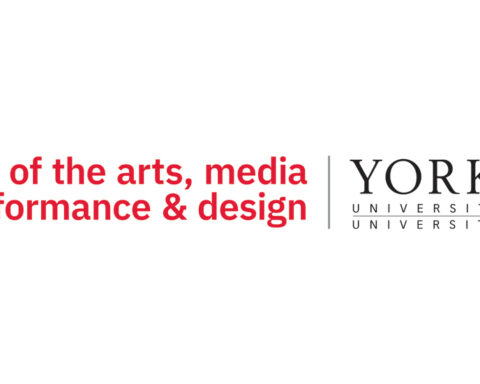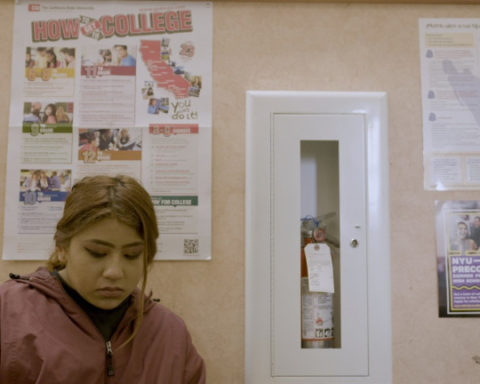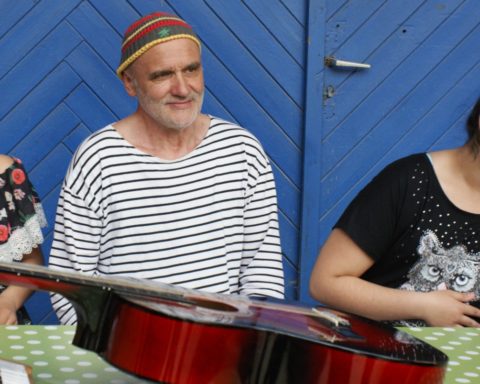This article is published as part of an ongoing exchange with DOX, the European Documentary Magazine.
Hands on versus Hands-off
After four years of enrolment in a standard film studies university programme, it’s likely that a graduate will walk away with a couple of shorts to their credit. But it’s rather doubtful that the student will have a viably marketable feature film tucked in his or her shoulder bag, ready to be pitched to international producers and networks for finishing funds. We can, however, predict that the second scenario is indeed true if we substitute training initiative for university programme.
All across Europe, documentary training initiatives are replacing the idea of a ‘graduate’ film degree and hurtling films into the international market in less than one year. Though the aesthetics of a university programme can offer the basic skills of filmmaking, it’s the practicalities and direct development of a training programme that can move a project from concept to secured budget quickly.
For documentary filmmakers, young and old, time is an unruly concept when shaping sto- ries derived from reality. Some projects need ten years, others mere months, which translates to less time outside the lecture halls and more time in the homes of one’s subjects, in the protest lines of the political movement, or up the mountain with the expedition, camera in tow.
Reality won’t wait for school credits to be tallied and tuition to be processed.
So why would one continue the snail’s paced approach to filmmaking if given the option to complete a large percentage of a documentary and secure an international co-production in just one year? In the last few years, filmmakers and industry educators are asking themselves the same question, and that’s precisely why European filmmakers are submitting proposals to training workshops across the continent. From Eastern Europe to the coast of France, documentary training initiatives are capturing the flavour of European life and penetrating theatres and networks at a rate that’s lapping academia by miles.
Three Easy Steps
Back in 1988, one of the first European training initiatives, EAVE (European Audiovisual Entrepreneurs) created development and networking programmes for audiovisual producers in Europe. EAVE invented a module structure of training which breaks development into three parts: the first session answers the artistic questions linked to the project, the second focuses on the technical aspects of budgeting and co-production, and the third provides an evaluation by experts through individual meetings and professional pitching. Since its conception, EAVE has delivered a variety of training programmes at international, pan-European, national and regional levels, with coordinators in 23 European countries.
Eurodoc is one of the leading documentary training programmes in Europe. Based in France, Eurodoc is specific to producers and seeks documentary projects, one-offs and series with a strong international potential from both young and fair-weathered professionals. Like most programmes of its type, Eurodoc accepts documentaries of all types, functions entirely in the English-language, and is composed of three-modules. Each of the sessions is held in a different country, spread over an eight to ten month period.
Like the EAVE structure, the three sessions are divided into storytelling, production development and the international market. Eurodoc’s first session, lasting for seven days and lead by top experts in the field—including some of the most distinguished producers and distributors in the international non-fiction sector as well as high-profile executives from TV broad- casters—focuses on analyzing the projects and evaluating their scripts, in both collective and individual sessions, in addition to exploring each project’s marketing strategy, legal issues and possible funding resources. session two fine-combs the packaging, financing and budgeting, while the third leg consummates in a final pitch to commissioning editors.
“Eurodoc is a training programme for producers and not for filmmakers,” points out the programme’s head, Anne-Marie Luccioni. And the reason for such role-specific training? In France, education is available to documentary filmmakers, but training for producers “simply doesn’t exist.” La Femis, France’s largest and most reputable film school, offers courses for producers of feature films but not documentary. And of the organizations that do touch on producing docs, Luccioni says, “they mainly provide technical information on how to make the budget, but there are very few things covered on the creative side.”
Documentary Campus Masterclass in Munich, Germany (re-titled last spring from Discovery Campus Masterclass) hosts a similar programme that combines workshops, individual tutoring, case studies and pitching. The programme is broken into four development sessions over a 10-month period. In its final October session, all projects are presented to commissioning editors at DOK, the international Leipzig Festival for Documentary and Animated Film.
Ex Oriente Film in Prague, Czech Republic, is the educational branch of the Institute of Documentary Film (IDF), which has nurtured some of the most talented and prospering creative doc-makers in Europe. Following Eurodoc’s model, Ex Oriente divides their programme into three sections of one-week periods where experienced producers, industry experts and TV commissioning editors counsel independent directors and producers on the development of their projects. Their film coordinator, Ivana Miloševič, however, sees Ex Oriente’s training as a separate entity from formal education. “Firstly, it’s hard to compare the two. University film programmes are for students who are in process of learning how to become a professional, while training programmes are mostly for people who are already supposed to be professionals. From my experience, these training initiatives are more effective for people who are ‘out of the school’ meaning they have completed initial training.”
Always treating their participants as professionals, Ex Oriente Film encourages year-round open communication with contributing experts. After the programme has commenced, both tutors and organizers keep a lively relationship with each project through follow-up support and international pr geared to aid the film’s development, festival release and distribution deals.
The primary aim of Ex Oriente Film is to find alternative channels and opportunities to support and promote creative East European documentaries that cannot be funded through standard TV sales. in the seven years since its conception, Ex Oriente Film has progressed from humble workshops to hosting the East European Forum, one of the leading pitching events that showcases 25 fresh projects to top commissioning editors from Europe and north America. In the last two editions of the East European Forum, American broadcasters have found Eastern gems to fit their sparse number of culturally diverse slots, which remains tiny due to the fact that subtitles tend to be the deal-breaker for most European documentaries gunning for north American broadcast. The truth of the matter remains that Americans don’t want to read their TV.
Both ITVs (which has funded more than 60 documentaries from 50 countries) and POV on PBS have attended the East European Forum, which organizes its third and final session during the Jihlava international Documentary Film Festival. Even the Sundance Documentary Film program was present in Jihlava last autumn to offer feedback to the pitched projects.
Exposure
Unlike national institutions for education, such as film academies and universities where training is specific to the country’s industry, Eurodoc’s mandate is to encourage and train the skills of the producer who seeks to develop his or her project on an international level. “Eurodoc welcomes producers that are always experimenting in their own territory, but who need to understand how to make a co-production through a network of professional co-producers,” says Luccioni. In many countries the money necessary for a documentary’s budget can’t be reached in one’s homeland. Building a co-production provides a chance for the film to have a larger budget and to circulate in different countries based on financing deals.
That is precisely why in the last year Eurodoc began to invite four or five non-European filmmakers to participate in the workshop, broadening the initiative’s international network. This past year, news from Canada brought two success stories back to Eurodoc from films previously developed within the programme. At Hot Docs, The One Man Village by Simon El Habre won the Best International Feature Documentary and Cooking History by Peter Kerekes was awarded the Special Jury Prize for an International Feature.
Ex Oriente Film has also nurtured small projects from the forgotten corners of Eastern Europe to the red carpets of Cannes and Toronto; for example, Bulgarian director Andrey Paounov’s The Mosquito Problem and Other Stories and Slovakian Juraj Lehotský’s Blind Loves. Rabbit a la Berlin by Polish filmmakers Bartek Konopka and Piotr Rosolowski was developed within the Documentary Campus and has been immensely successful. It too won a top award at Hot Docs and was selected to screen as part of the international Documentary Association’s DocuWeeks last August, as a possible contender for an Academy Award nomination.
Such success is attributed to the blazing talent of the filmmakers no doubt, but practical outcomes of such training programmes could also be a lending factor. Participants come away with an ability to recognize and assess the potential of creative documentary film and with the proper skills and know-how fostered within a matter of weeks, they work fast within that parameter to stay current within market trends.
Statistics
Documentary training initiatives sprouted from a need of broadcasters to keep up with the influx of non-fiction media coming at them in all shapes, sizes and languages. These programmes have shortened the gap between factual broadcasters and filmmakers and betwixt linguistic and cultural barriers, creating a summit space that can nail twenty-some-odd projects with a couple of well thrown stones. In other words, commissioning editors take a seat at a round table and can potentially acquire their slot’s newest projects in a few afternoons. This cuts out endless meetings, paperwork and slow-to respond question and answer periods. By bringing filmmakers and broadcasters together in the live-action ring, a new alliance has emerged which provides direct information about the variety of content being produced and the specific demands of the broadcasters.
The cultural and geographical dynamic of Europe is what forces filmmakers from the East to show the West what they got. When faced with the number of Eastern European broadcasters with limited budgets, doc-makers from that region have to find the international dimension of their stories, which means thinking outside of their nation to accrue stories that are globally viable. Given the fact that Europe is home to a large roster of cultures, costumes and histories, it becomes more of a challenge for a filmmaker from Slovakia, for example, to make a documentary that British or American broadcasters find intriguing for their audiences. That’s precisely why such programmes like Eurodoc, Documentary Campus and Ex Oriente Film exist within Europe—to wrangle the regional folklore and indigenous talent and coax it towards the international market.
Ex Oriente Film can vouch that two-thirds of all the films that completed the programme have been successfully produced. In 10 years, Eurodoc has received more than 520 professionals from 42 countries, both participants and training experts, and more than 130 films have been delivered, with almost thirty more currently in production. Keep in mind that such programmes total only three weeks of training, compared to 4 years and 8 semesters of school. The Documentary Campus reports that up to 70% of projects that undergo their Masterclass are successfully produced. If 70% of all student projects were produced and broadcasted on international networks, it’s likely that film students would remain permanently enrolled to nurture and support their artistic processes. Ironically, it’s the condensed nature of these training programmes that gets the films made. Participants are motivated to finish their projects because there’s incentive in the form of network funding. The pitching is fixed, thus participants must produce a viable trailer, a tight proposal and be prepared to talk their project inside out.
Of course, reality throws up its own roadblocks. After being given a few training sessions and less than a year to develop a documentary, a filmmaker might start with one idea and halfway through the project encounter unforeseen difficulties, forcing a change of lanes. This happens in every artistic process but the final flag for a successful TV doc is expected to be waved within a year—or at best eighteen months. Some filmmakers crash and burn in that process.
In the 2008 edition of Ex Oriente Film, one polish-based filmmaker found himself in story stalemate. In the first winter session, director Thierry Paladino successfully proposed a documentary that focused on the whimsically ageless tradition of puppetry, but he returned to the summer session with major plot problems. To kick off the first day of session two, Paladino rose to the head of the classroom and confessed, “I’m in the shit.” Of course Paladino and his team steered the story out of the excrement. After pitching at the East European Forum, paladino won the IDFA FORUM Award, which grants free participation to pitch at the international Documentary Festival Amsterdam’s Forum.
United States Crash Course
Archidoc, Berlinale Talent Campus, Baltic sea Forum, Docs in Thessaloniki, Dragon Forum, EAVE, INSIGHT OUT, Lisbon Docs, SOURCES 2 and the Greek Documentary Lab, are just some of the other documentary training programmes in Europe.
The United States has the Sundance Institute. At least—and possibly at best.
The Sundance Institute Documentary Film program selects Lab Fellows from current grantees, who were initially chosen from a worldwide proposal process. Deadlines are generally twice per year with between 500-1000 submissions considered in each round. Approximately 15-25 awards are granted with only four film projects (totaling eight to ten participants) attending the sundance Documentary Edit and Story Lab each year.
That’s tough competition. Ex Oriente Film annually receives less than a hundred applications from which 14 projects are chosen. Of course, Ex Oriente Film fishes from a smaller pond (either the producer or director team must hail from an East European country) with the work’s intention differing as cultures are crossed, ultimately altering the gauge of success. European filmmakers who complete training and successfully pitch their films will enjoy a broadcast on television, revel in a theatrical release, and have a healthy tour of international film festivals. The independent film tradition of the United States wades in much deeper, and competitive, financial waters. Filmmakers are status-magnets, so naturally, docs that come out of sundance are likely to receive Academy Award nominations. Take, for example, Trouble The Water, My Country, My Country and Nerakhoun (The Betrayal). All were Sundance Lab fellows with Oscar nominations.
There are other programs in the United States which offer doc-specific filmmaking training, but they’ve seemed to slip under the radar: Film Independent hosts Project Involve, The Bay Area Video Coalition offers the Producer’s Institute for New Media, and Cinereach grants the Reach Film Fellowship. Regardless of alternatives, the artist support programmes of the sundance institute are considered unique in the United States. “They’re designed to be an artist-to-artist intensive experience with an emphasis on the creative process,” says Rahdi Taylor, the Associate Director of the Sundance Institute Documentary Film Program. “Our creative labs are special residential retreats where the art of nonfiction storytelling is engaged with rigor and candor. Risk-taking and experimentation with the work is a supported goal.
“In the United States,” continues Taylor, “non-profit organizations such as Sundance Institute must fundraise annually from foundations and individuals, as well as develop strategic partnerships in order to deliver our vision of supportive and creative artist development.” It seems the US system makes for stiff competition and a tough time securing film funding. On the upside, those sundance projects that do emerge from under 1000 paper concepts and potential films seem to come up roses—and we get innovative documentaries that explore critical and contemporary issues.
Conclusion
Financial and educational support for project development is amply found in both public and government programmes across Europe. And although the US system best demonstrated through Sundance can be rigorously competitive due to the course of capitalism, no one can argue that it does produce results of a high cinematic calibre. In the end, it really comes down to the choice of the filmmaker—their method to completion and their definition of status. Grants or credit cards? But what is most encouraging is the fact that practical means are out there, which provides a very realistic opportunity for young filmmakers to continue their education and get their docs on the screen and in the scene.











